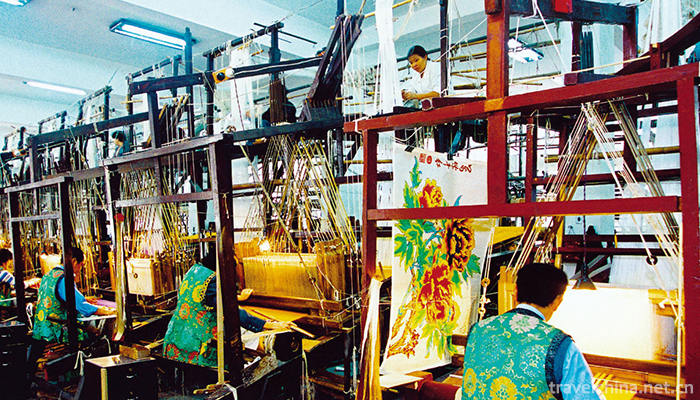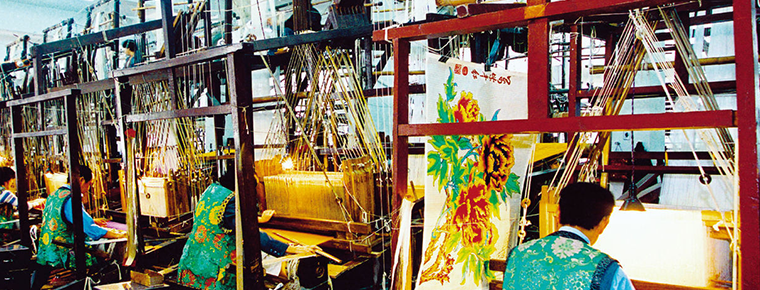Lu Brocade Weaving Techniques
Lu Brocade Weaving Techniques
Lujin brocade weaving technology, traditional handmade brocade weaving technology in Juancheng County, Shandong Province, is one of the national intangible cultural heritage.
The manufacturing process of Lu brocade weaving technology is complex. It needs 72 processes, such as spinning, dyeing, cloth pulp, warping, healing, breaking, cutting and weaving, to produce Lu brocade finished products.
On June 7, 2008, Lu brocade weaving technology was approved by the State Council of the People's Republic of China and included in the second batch of national intangible cultural heritage list, heritage number: _-103.
historical origin
The weaving of Shandong brocade has a long history. During the Yuan and Ming Dynasties, along with cotton planting on a large scale in the Yellow River valley, the people of Southwest Shandong kneaded the traditional techniques of Ge, Ma, silk and embroidery into cotton spinning, forming the cotton brocade in Southwest Shandong. At that time, Lu Jin's craftsmanship was relatively rough, with monotonous patterns and fewer varieties. With the renewal of textile machinery and the application of chemical dyes, Lu Jin process has been greatly improved.
In the Qing Dynasty, Juncheng Lu Jin was presented as a tribute to the court by local officials and became a precious treasure.
After the liberation of New China, the peasants in the land reform got their land. Cotton with high economic value has been widely planted. Despite the impact of three years of natural disasters and the 10-year Cultural Revolution, cotton planting area decreased for a time.
After the reform and opening up, foreign cloth occupied a large market share. But on the whole, due to the improvement of consumption capacity, the demand for cotton cultivation and cloth is much higher than before. The important reason for the rapid development of brocade weaving in Lu Dynasty is that the number and types of brocades accompanied by Lu Dynasty increased sharply in the 1980s.
Process characteristics
Types
Lujin brocade can be divided into two pieces (two pieces of plain weave fabric) and four pieces (four pieces of twill weave fabric or variational weave fabric) according to the number of heddles used in weaving.
Lujin brocade is classified according to the weaving effect of the color on the surface of the fabric, including stripes, checks, jujube pattern, water pattern, combo pattern, goose-eye pattern, Jewish hoof pattern and so on. According to weaving techniques, Lu brocade can be classified into five categories: jacquard Lu brocade, canvas instead of brocade, Dahua Lu brocade, Baohua Lu brocade and Tinhua Lu brocade.
Lufei is classified into stripes, checks, jujube pattern, water pattern, combo pattern, goose-eye pattern and Jewish hoof pattern according to the effect of weaving on the surface of the fabric. According to weaving techniques, Lu brocade can be classified into five categories: jacquard Lu brocade, canvas instead of brocade, Dahua Lu brocade, Baohua Lu brocade and Tinhua Lu brocade.
- Patterns
In the long weaving years, skillful farm women have constantly innovated and improved Lu brocade technology, gradually forming a unique style of modern jacquard, floral, and flower-picking technology, which is rich and beautiful, rough and refined. The pattern of Lu Jin has developed from the initial twill, stripe and square pattern to the more complex pattern of jujube pattern, water pattern, combo pattern, goose-eye pattern, cat's hoof pattern.
The various shapes of Lu Jin patterns are not confined to the reality of objective things, but a subjective and arbitrary creation, which is in line with the people's inner requirements and aesthetic feelings, and is an aesthetic realm of "complacency and forgetfulness of images". The artistic conception of Lu Jin's design is embodied by various geometric shapes interwoven with various color lines, rather than the concrete image of things. Parallel, repetitive and continuous through abstract patterns. Spacing, contrast and other changes, forming a unique rhythm and rhythm, it reflects the life of the form is tortuous, indirect, and therefore more artistic charm.
Color
The commonly used colors of Lu Jin are bright red, peach red, Lake blue, indigo, green, black, yellow, brown, white, etc. Lu Jin's color is very bold, the color contrast is strong, the style is bright and bright, which reflects the bold and relaxed personality. Lu Jin's requirement for color matching is bright, which is the aesthetic of color matching, and is also the principle and standard of Lu Jin's use of color. Bright standard is to choose high brightness and purity of color, strong contrast, with a very strong decorative effect, give people a bright, warm feeling. The combination of different patterns and the interweaving of different color lines make Lu Jin present different artistic effects.
Technological process
Lu brocade weaving needs nine main processes, including warp spinning, dyeing, pure yarn, warp yarn, threading, brushing, reeling, crane and weaving, each of which includes many sub-processes. Use spinning wheel, spindle, warp pole, warp fence, bar, brush, loom, shuttle and other tools. Reeling is an important process in brocade weaving. The more the reeling, the more the changes of the texture formed, and the more colorful the pattern of the fabric. Machine weaving can only weave two and four reels, while hand-woven Lu brocade can weave six and eight more complex reels.
The weaving of two reel fabrics is relatively simple. There are only two reels on the loom. There are two feet creeping under the loom. When you step on the first foot, you pull the warp thread and form a knitting opening. The right hand shuttle, the left hand shuttle, the second foot creeping, closing the knitting opening, and moving the rope frame to tighten the weft, you complete a weaving process. In this way, if you weave with a single-color weft of a shuttle, you can weave more than 30 feet of cloth a day. Because the change of two reels only has the fixed law of opening and closing up and down, besides the change of weft color, the fabric texture has no obvious undulating texture, so the two reels are usually called plain weaving.
Although the weaving process of the four reels is the same as that of the two reels, the increase of reels determines the difficulty of weaving. The order of the four feet under the loom in weaving different patterns and the order of the two groups of combination are also different. Each time two feet are stepped down, different longitudes are driven to form opening. After shuttle throwing and weft transferring, the other feet are stepped down to tighten the longitude, and the weft is tightened by rope frame. It's not the last combination of two feet when you step on tiptoe again, but different adjustments according to the fabric design.
When weaving Lujin brocade, different numbers of shuttles are usually prepared according to the design of the fabric. There are at least one shuttle and at most a dozen shuttles. Usually 4-5 shuttles are used most. The more the shuttle is used, the richer the color is, but frequent shuttle change will affect the speed of weaving, so the more the color of weft, the lower the weaving efficiency of fabric.
Inheritance and protection
Inheritance value
Lu brocade weaving technology uses natural raw materials, pure manual weaving, with antistatic, non-deformable, breathable sweat absorption, warm winter, cool summer and many other advantages. Jiaxiang County has developed many exquisite brocade products, such as clothing, home textiles, bags, jewelry and so on. It caters to the needs of all kinds of people and enables people to experience comfort and health in green consumption and feel simple and elegant.
Inheriting characters
Zhao Fangyun, female, Han nationality, born in July 1944 in Gaozhuang Village, Zhongshan Township, Jiamian County, Shandong Province. In June 2009, Zhao Fangyun was selected as the representative successor of the third batch of national intangible cultural heritage projects. Jiaxiang County of Jining City declared the project: Lu brocade weaving skills.
protective measures
In December 1995, the Lu Jin Art Museum of China was established in Juancheng, and Lu Jin's manufacturing skills were inherited and protected.
In January 2005, Juncheng Lujin Handicraft Co., Ltd. was designated as "Shandong Tourism Commodity Research and Development Base" by Shandong Tourism Bureau, devoted to the protection of Lujin weaving skills.
social influence
Honorary commendation
In May 2004, Lu Jin won the Excellent Award in the "Golden Doctor Cup" National Rural Youth Arts and Crafts Design Competition sponsored by the Central Committee of the Communist Youth League and the Chinese Artists Association;
On June 8, 2007, Shandong - Chenglujin Museum won the first Cultural Heritage Day Award promulgated by the Ministry of Culture.


-
1.Water surface
The water surface is a traditional snack in Shaanxi and Gansu Province. Legend has it that Liu Bang, the ancestor of the Han Dynasty
Time 2018-11-02 -
2.Big and Small Size Dongtian Scenic Spot
The Size Dongtian Scenic Area (formerly known as the Haishan Scenic Spot and Aoshan Scenic Spot) is located in the southern corner of Nanshan Province, 40 kilometers west of Sanya City
Time 2018-12-12 -
3.Lang Mountain Scenic Area
Langshan is located in the northwest side of the hinterland of the Yuechengling Mountains, which is the longest in Wuling Mountains. It spans Xinning County and Resource County
Time 2018-12-12 -
4.Qingshuihe Ming Great Wall Site
The site of the Great Wall of the Ming Dynasty begins at Jiayuguan in Jiayuguan City in the west, passing through Jiuquan, Gaotai, Linze, Zhangye, Shandan, Yongchang, Minqin
Time 2019-02-07 -
5.Weaving Techniques of Tibetan Bangdan and Kapa
The woolen apron commonly used by Tibetan people is called "Bangdian" in Tibetan, which has the functions of decoration and cold resistance. Jiedexiu Town, Gongga County, Shannan District, T
Time 2019-04-05 -
6.the Dong chorus
Originated in the Spring and Autumn Period and the Warring States Period, the Dong Grand Song has a history of more than 2500 years. It is a folk chorus form with multi-voice
Time 2019-04-27 -
7.Hui Folk Stories
Hui Folklore Stories is a book published by Ningxia People's Publishing House in 2009 by Li Shujiang and Wang Zhengwei.
Time 2019-05-04 -
8.The game of go
Go is a strategic two-player game. It was called "game" in ancient China and "Go" in the West. Popular in East Asian countries (China, Japan, Korea, Korea), is one of the four arts
Time 2019-06-26 -
9.Diagnosis of Traditional Chinese Medicine
Diagnosis of traditional Chinese medicine, one of the traditional Chinese medicine, is declared by the Chinese Academy of Traditional Chinese Medicine, one of the national intangible cultural heritage
Time 2019-08-10 -
10.Daofu steamed bun with beef and mutton
Steamed bun with beef and mutton is a special traditional delicious food of Hui nationality. It is famous at home and abroad for its strict selection of materials, cooking essence, rich nutrition and mellow taste. The eating method of beef and mutton steamed
Time 2020-12-06 -
11.Deyang Sports
In 2017, Deyang City built 791 national fitness routes and 608 national fitness projects. At the end of the year, there were 10 public stadiums and stadiums, and the annual sales of sports lottery tickets were 160 million yuan.
Time 2020-12-14 -
12.Dazhou Communications
In 2019, the postal and telecommunication business income will be 3.103 billion yuan; at the end of the year, there will be 706600 fixed phone users and 4.1544 million mobile phone users, including 177600 3G mobile phone users and 2.9382 million 4G mobil
Time 2020-12-20